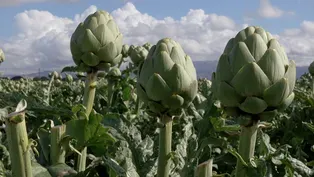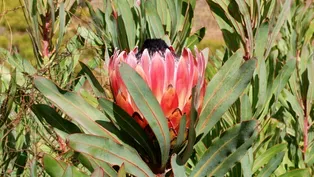
Caramel Apple Crisp – Farm to Fork with Sharon Profis
Clip: 6/30/2023 | 5m 25sVideo has Closed Captions
Follow along as we cook up a sweet Caramel Apple Crisp.
Follow along as we cook up a sweet Caramel Apple Crisp.
Problems with Closed Captions? Closed Captioning Feedback
Problems with Closed Captions? Closed Captioning Feedback
America's Heartland is presented by your local public television station.
Funding for America’s Heartland is provided by US Soy, Sustainable Agriculture Research and Education, Rural Development Partners, and a Specialty Crop Grant from the California Department of Food and Agriculture.

Caramel Apple Crisp – Farm to Fork with Sharon Profis
Clip: 6/30/2023 | 5m 25sVideo has Closed Captions
Follow along as we cook up a sweet Caramel Apple Crisp.
Problems with Closed Captions? Closed Captioning Feedback
How to Watch America's Heartland
America's Heartland is available to stream on pbs.org and the free PBS App, available on iPhone, Apple TV, Android TV, Android smartphones, Amazon Fire TV, Amazon Fire Tablet, Roku, Samsung Smart TV, and Vizio.
Providing Support for PBS.org
Learn Moreabout PBS online sponsorship♪♪ [Sharon Profis] Today, we're making one of my favorite fall recipes and we're making a Caramel Apple Crisp.
And I love to make it when the season starts to change and apples start to hit the grocery store and farmer's market.
So, let's get started by making our filling.
I have six Honeycrisp apples here.
I'm just going to go ahead and peel all of these apples.
And for this recipe, I'm choosing to use one variety of apple.
I keep turning to the Honeycrisp apple because it's just so well balanced.
It's sweet and tart, and it also keeps its shape as it bakes.
With all our apples peeled, now let's go ahead and slice them.
My preference for size, when it comes to a crisp or even a pie, is to go a little bit wider than I think is typical.
I just really like to actually bite into the apple.
And this bakes for quite some time, so it's going to break down, it's going to get softer.
So, it's a little less than a quarter of an inch.
All our apples are sliced.
Now, let's put the rest of our filling ingredients in this bowl too.
To this, we'll add a quarter cup of brown sugar, a teaspoon of cinnamon, we'll do a pinch of sea salt, three tablespoons of tapioca starch.
This will make sure that the filling stays nice and thick because the apples, as they cook, they will release juices and we want the tapioca starch to kind of catch those juices.
We'll also do half a teaspoon of vanilla extract and the juice of half a lemon.
So, that's about two tablespoons.
We'll give this a mix.
All right.
Our filling is ready.
Let's go ahead and make our crisp topping.
In this bowl, I have one cup of flour and one cup of oats.
And to that, I'll add about a third of a cup of chopped walnuts.
Now, we're making a crisp.
Really, the difference between a crisp and a crumble is that with a crisp, you have a few more add-ins like those oats and those nuts.
To that, I will add a quarter cup of brown sugar, a pinch of salt, and then the good stuff- half a cup of unsalted butter.
And get it all combined.
So, the flour and the sugar and the oats are starting to absorb that butter.
And once you see no more dry spots of flour, you know your topping is ready.
To bake this dish, you can either use an eight by eight or nine by nine pan.
In this case, I'm using a cast iron skillet and we'll pour all of the apples and any juices that may have accumulated at the bottom right into our skillet here.
And then, let's get our crisp topping.
There's really no science to this.
We just want to make sure it's as evenly distributed as possible.
You'll get some flakier pieces, you'll get some, uh, chunkier pieces.
That is the fun of a crisp.
How beautiful is that?
Oh, my gosh.
This is ready to go in the oven at 350 degrees for about 45 minutes.
We're looking for a nice golden-brown topping.
In the meantime, while this is baking, let's go ahead and make our caramel topping.
For this sweet and slightly salty caramel sauce, you'll need one cup of granulated sugar, a quarter cup of water, half a cup of warmed heavy cream, two tablespoons of unsalted butter and one teaspoon of salt.
In a saucepan over medium heat, add the sugar and water.
Let it simmer and bubble until it turns a deep, golden brown.
It'll take about eight to 10 minutes.
Here, you'll want to keep a careful eye on it to make sure it doesn't burn.
That can happen quickly.
Finally, slowly add the heavy cream and whisk for a couple minutes until that mixture looks smooth.
Then, turn off the heat and whisk in the salt and butter.
Serve this caramel sauce warm right away, or store it in the fridge for two to three weeks.
Our crisp is out of the oven and it smells so good.
The cinnamon, the apples, the caramel- let's put all these things together.
So, first, I want to go ahead and add the caramel right on top.
I went ahead and kept this caramel warm.
And that's why we didn't add a ton of sugar to either the topping or the filling, because this is really going to give us that sweetness.
Take a nice portion from here.
Oh, man.
The apples have baked so nicely.
How gorgeous is that?
And you can see the tapioca starch really kept all of those juices together.
Let's get a nice scoop of ice cream, of course, right on top.
And of course, more caramel.
Tell me that is not the most beautiful, welcoming dessert you have ever seen.
Well, now all that's left to do is eat!
♪♪
Video has Closed Captions
Clip: 6/30/2023 | 3m 54s | Meet Georgia farmers supplying “imperfect” produce to the Atlanta Community Food Bank. (3m 54s)
Video has Closed Captions
Clip: 6/30/2023 | 4m 56s | Artichoke farmers reveal why you shouldn’t be intimidated by this thorny crop. (4m 56s)
Video has Closed Captions
Clip: 6/30/2023 | 5m 45s | Journey up steep terrain in San Diego County to see how farmers grow protea flowers. (5m 45s)
Providing Support for PBS.org
Learn Moreabout PBS online sponsorshipSupport for PBS provided by:
America's Heartland is presented by your local public television station.
Funding for America’s Heartland is provided by US Soy, Sustainable Agriculture Research and Education, Rural Development Partners, and a Specialty Crop Grant from the California Department of Food and Agriculture.














